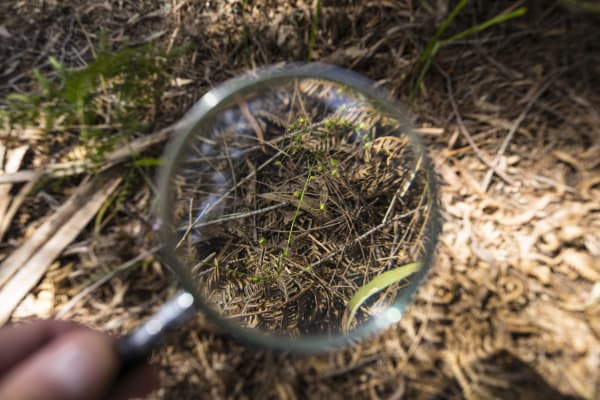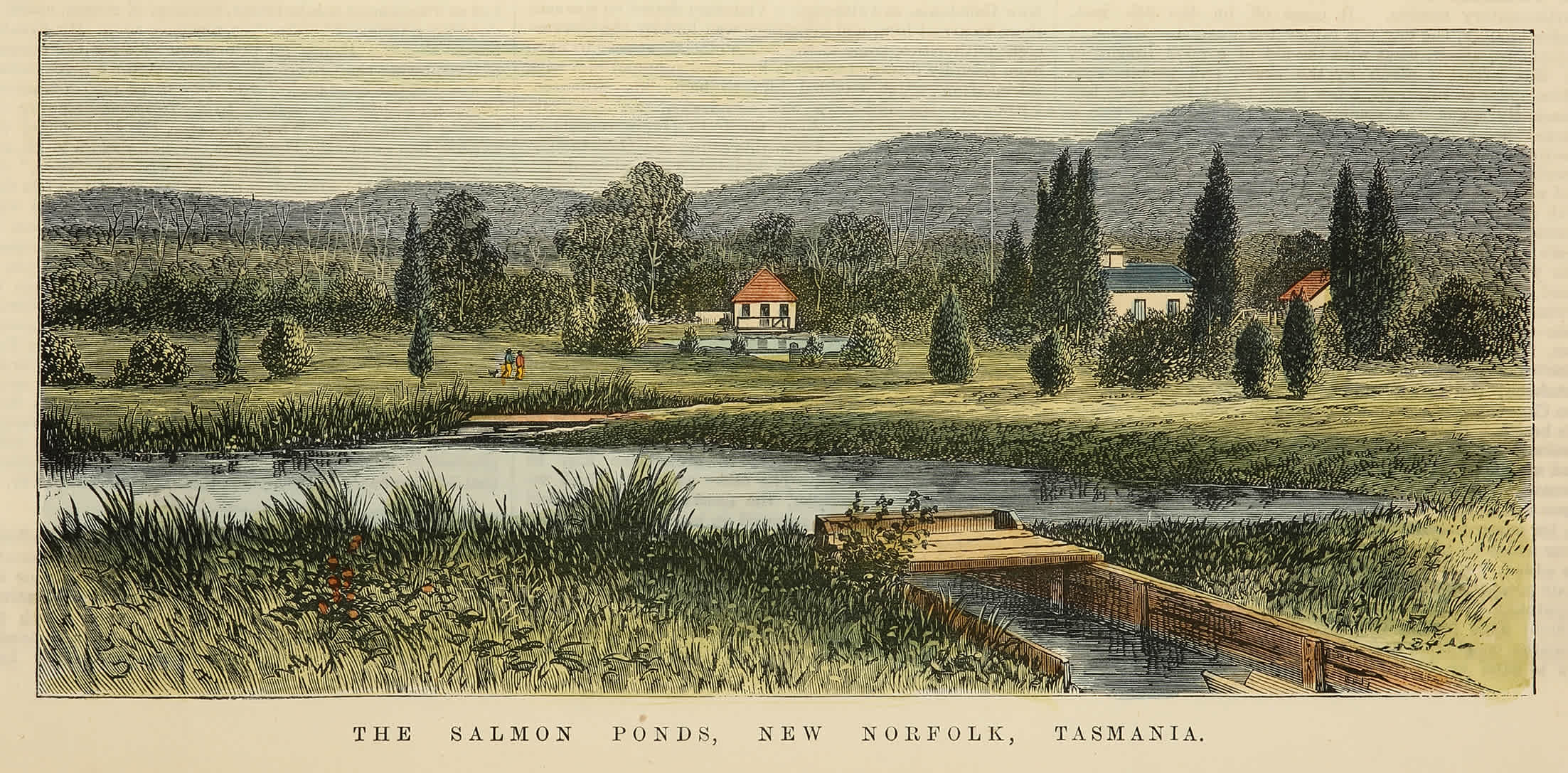If everyone looked after their piece of the planet as well as Phil Collier and Robin Garnett, it would be a much healthier place.
Ten years ago they were the first to buy land under the Tasmanian Land Conservancy revolving property fund. This is a system through which the TLC buys high conservation-value land, protects the habitat for threatened fauna or flora with covenants, then resells to conservation-minded buyers.
Their 20-hectare property near Port Sorell contains 12 threatened plant species including five rare orchids, one of which, the marsh leek orchid, Prasophyllum limnetes, is found only on the property. The rare wrinkled dolly bush, Cassinia rugata, only previously recorded in Tasmania by Rodway in the 19th century, is now known at only one other Tasmanian location. The dolly bush benefits when its marshy habitat is burned, but then recovers much better if protected by small cages, because native animals find the new re-growth very palatable.

Collier and Garnett take a delight in working outdoors on their property. They are busy in March and April with controlled burns on a mosaic pattern. This reduces the amount of dense vegetation and allows small native plants, including many of the threatened species, a chance to have their time in the sun.
The indoor work includes recording data about the 1,350 orchid specimens that they have plotted on their property and examining fungi spores under their compound microscope to see if there might perhaps be an interesting or new species. Phil and Robin have prepared an inventory of the wildlife on their property (six types of frog, lizards, snakes and a suite of mammals), and they monitor birdlife.
TLC bought the property in 2003 after local orchid specialist Peter Tonelli had discovered several species of rare orchids there. Before this, Tonelli had found about fifty species of orchids on forestry land near Latrobe, and this area has become the Henry Somerset Orchid Reserve.

Before buying their place, Robin Collier and Phil Garnett needed to be persuaded that they would be able to achieve positive results, using the methods documented in the Nature Conservation Plan. TLC field officers Jim Mulcahy and Denna Kingdom coordinated with the local TFS to conduct several trial burns which convinced them that this was feasible in a peri-urban environment. Some slashing is needed to create fire breaks and to cut under trees to avoid alarming neighbours with a fire running up the rough bark. There is also plenty of other work for their tractor, including carting some types of shrub away before a burn to avoid mass germination of young shrubs that may crowd out the precious rare plants.
Some low-lying parts of the property are described as ephemeral wetland. But after recent rains, there was nothing ephemeral about the wetness when we walked around the place in gumboots.
Collier and Garnett were prime movers, along with John Thompson of Gunns Plains, in starting Conservation Landholders Tasmania (CLT), which enables people with covenanted land to meet on a regular basis, exchange ideas and listen to talks from experts. There are 150 people on the CLT email list with the scope for this to increase. Members have been able to advise each other on such matters as weed control, fire management, rehabilitation of degraded land and pest animals. Their gatherings have also considered the value of conservation land in the landscape and the motivators for people involved in its protection.
Garnett said, “It is very satisfying to have a well-defined and valuable project keeping us busy in retirement."
"Some properties can be managed with little effort but ours needs active management with a fire regime required to maintain the priority plant species on our property.”
We drove around to the other side of the Rubicon Estuary to the Panatana property where Collier and Garnett would be showing visitors around on an Open Day a fortnight later. Panatana has been bought by a partnership between the Tasmanian Land Conservancy and the Indigenous Land Corporation, and it will now be managed as a private reserve. Not far south of Narawntapu National Park, Panatana encompasses some beautiful vegetation and habitats. About two kilometres in from Bakers Beach Road, we emerged onto the shore of the Rubicon Estuary, the southern part of Port Sorell. It is home to more than 1 per cent of the world's population of pied oystercatchers, and is also popular with double-banded plovers in winter and other wading birds in summer.
The three-metre tidal variation leaves an extensive fringe of saltmarsh habitat high and dry at low tide. This includes gnarled old shrubby glassworts, Tecticornia arbuscular, sometimes rumoured to be up to 100 years old. Just in from the shore is a grove of Melaleuca ericifolia and further inland are stands of black gum, Eucalyptus ovata. Both species don't mind having their feet in the water, and both form threatened vegetation communities. There are also large areas of black peppermint, Eucalyptus amagdylina, which prefer drier sandy soil.
In a clearing amongst the black peppermints, we found ourselves in a grove of grass trees, Xanthorrea australis, in full bloom and being feasted on by native bees and butterflies. Near here we saw several Aboriginal middens; being a windy day, it was not hard to understand why they would have come this far inland to eat their shellfish.

Collier and Garnett delighted in showing us several different orchids, of which the parson in the pulpit, Glossodia major, was the most prolific, and pink fingers, Calladenia carnea, the most arresting.
We pushed our way through tea trees towards a frog chorus emanating from two small lagoons that are surrounded by marsupial herb fields, another highlight of Panatana. However due to the recent wet weather, the herb fields were temporarily inundated.
TLC’s Sally Bryant said, “We protected Panatana as a nature bank because it is an intact, functioning ecosystem. It contains everything it should have in its natural state, from the grassland level up; the understory, orchids, grasses, trees and all the other life that they support. Panatana, and other such reserves, will become feeder areas for the surrounding landscapes. Panatana will become a source population for surrounding landscapes in the future.”
Panatana is a very peaceful area where one can readily imagine the island’s original inhabitants living in harmony with nature for millennia.
. . .
EDITOR’S NOTE: This article first appeared in Issue 84 of Tasmania 40°South magazine. Since its publication, Phil Collier and Robin Garnett – who named their property Rubicon Sanctuary – have returned to the UK and donated the property back to Tasmanian Land Conservancy. Rubicon is currently being managed by volunteer caretaker Alison Roach.
More in formation about Tasmanian Land Conservancy can be found at tasland.org.au.










